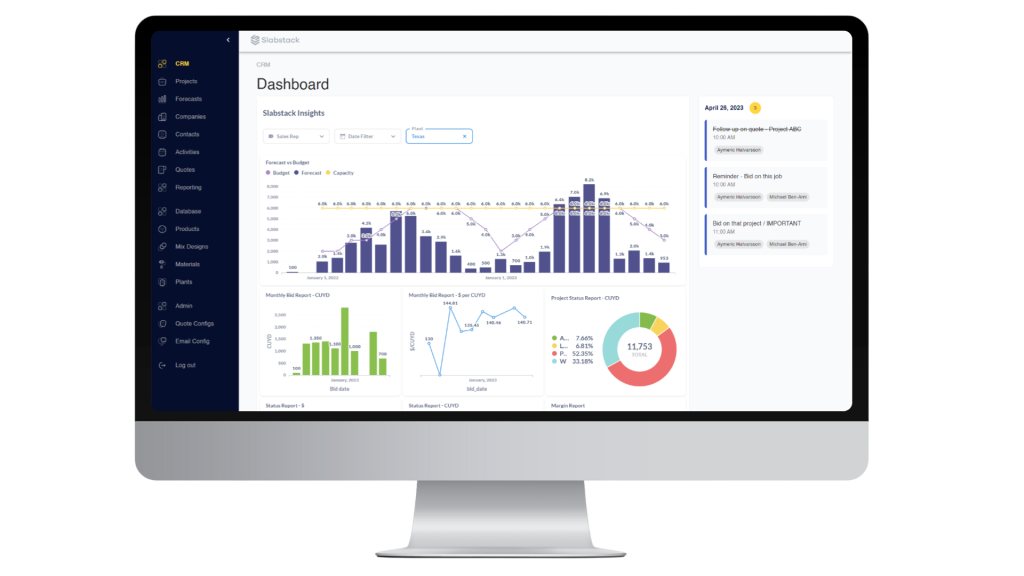Building material supplier software: What to look for in a high-ROI CRM (2025 guide)
Author: Aymeric Halvarsson
Running a heavy building materials supplier business is already complex. You’re juggling live costs, delivery schedules, approvals, and sales—often across multiple plants.
And if you're using spreadsheets or a generic CRM not built for suppliers, you're making it harder for your team and likely losing money. Studies show that an average company loses 12% of its revenue due to bad data. For a business making $10 million a year, that's $1.2 million lost.1
That’s why we created this guide to help evaluate what a supplier-specific CRM should really offer, how to choose one that fits your operation, and what kind of ROI you should expect, based on real-world results.
Why spreadsheets & horizontal CRMs fall short for building material suppliers?
Before we dive into what your CRM should have, let’s understand the common pitfalls of spreadsheets and generic CRM tools.
Spreadsheets are error-prone
A simple Excel file can turn into a maze of linked tabs, hidden formulas, and conflicting versions over time.
One misplaced reference or an unwitting edit can corrupt your entire quoting engine—often discovered only after a customer spots a typo or calls about an outrageous price. Plus, there is always a risk of human error when your team is manually putting in all the information.
Generic CRMs miss material-specific quoting
Generic platforms like Salesforce might excel at contact tracking or opportunity forecasting, but they lack heavy-materials intelligence, which is extremely important in this industry.
They don’t understand mix IDs or fuel surcharges, and they can’t automatically pull the right delivery zones. That means your sales team ends up doing manual work to make the system fit—copying static prices, adding line items by hand, and managing margin calculations in spreadsheets.
No real-time cost visibility
When cement, diesel, or additives jump in price, your spreadsheet stays static until someone updates it—if at all. A generic CRM may pull billing rates, but a true building-materials system keeps a tab of live material costs, so every quote reflects what the current prices are.
Margin leaks and sales teams undercutting each other
Without automated guardrails, reps can unintentionally quote below your target profit to win business. In spreadsheets, you have to remember to copy a “target margin” cell, and in horizontal CRMs, you must build custom validation rules.
Both approaches lead to inconsistent enforcement, surprise write-downs, and worse, eroded customer trust.
Then there is also the issue of a lack of visibility across your sales organization.
When reps rely on spreadsheets or generic CRMs, they can’t determine what the minimum order value should be. That often leads to underbidding—not just against competitors, but also against each other. One rep cuts $5/ton to win a deal, and another hears about it and cuts even more. This drives prices down and hurts your profits.
Time wasted on manual work
Reps should be selling, not juggling multiple windows to find data. Every minute spent on admin work like copying quotes from Excel to email, chasing approvals, or fixing errors is revenue lost.
Your business needs a unified system that ties quoting, dispatch, and invoicing together—so your team can work on what they do best, getting new customers.
But what exact features should you expect from a building materials CRM? Let’s find out.

Top 5 features to look out for in a CRM for building material suppliers
1. Live cost feeds & dynamic pricing
A purpose-built CRM connects directly to your plant’s cost database or dispatch system, like Command Alkon and Sysdyne, to pull up-to-the-minute material prices of cement slurry, asphalt binder, aggregate grades, along with fuel rates and additives.
When your sales reps are working from the same live pricing data, it adds visibility across the organization, and you eliminate internal underbidding. Everyone sees the same costs, works from the same numbers, and protects your margins.
2. Business intelligence
Beyond quoting, you need visibility into how your business is actually performing. A CRM for material suppliers offers dashboards that display win-loss rates by mix design, average margin per region, and quote-to-order cycle time.
Their analytics module breaks down revenue drivers like hit-rate improvements, reduced credit holds, and faster quote turnaround.
3. Two-way dispatch & ERP integration
One of the most important features of a true building-materials CRM is that it doesn’t live in isolation. It pushes accepted quotes back into your dispatch system as tickets, and pulls actual delivered volumes, weights, and job statuses back into sales.
This bi-directional flow keeps your dispatchers and accounting teams synchronized without manual data entry. It connects from Command Alkon and Sysdyne, lets you launch orders directly from the CRM, track driver ETA, and close the loop on billing in real time.
4. Margin floors & approval workflows
Your profit targets shouldn’t be an afterthought. Through a good CRM, you set minimum acceptable margin bands—by material, by plant, or by customer segment—and any quote falling below those thresholds automatically routes to a sales administrator or manager.
This enforces discipline without slowing down day-to-day quoting: reps can still produce drafts in minutes, but no one sends a price sheet that leads to loss.
5. Forecasting & demand visibility
A supplier-focused CRM doesn’t just track what’s been quoted—it also helps you forecast what’s coming.
With visibility into current quoting activity, seasonal patterns, and historical win rates, you can plan inventory, adjust pricing, and prepare your plants for demand. These insights will help your team stay proactive instead of reactive.
And beyond forecasting, these systems break down key revenue drivers like hit-rate improvements, fewer credit holds, and faster quote turnaround, so you can understand exactly where your margin gains are coming from.
Now let’s take a closer look at how a good CRM provides value for money from day one.

Evaluating ROI: Why building material supply software outperforms spreadsheets and generic tools
A purpose-built CRM might seem like a big investment at first, especially if you’ve been using spreadsheets or patching together a generic CRM. But when you measure the return, the right system pays for itself in just a few weeks. Here’s how:
Faster time to value
Manual quoting workflows cost your team hours every week. Between chasing prices, cleaning up quote errors, and re-entering data across tools, you’re losing time that should be spent selling.
A supplier-specific CRM streamlines this immediately—quotes go out faster, cleaner, and with fewer errors from day one.
Better margin capture
When quoting is left to spreadsheets or general CRMs, there's no control over margin targets. Sales reps might undercut pricing without realizing it.
A strong CRM sets guardrails in the quoting workflow, flagging low-margin bids before they go out and enforcing review when needed. Combined with automated cost feeds, this protects every quote from price changes in fuel, cement, or asphalt.
Higher close rates
Quoting isn’t just about sending numbers, it’s also about follow-up, accuracy, and timing. A supplier CRM tracks every quote in one place, with reminders and version history that help reps stay on top of every deal. This means fewer forgotten leads, cleaner handoffs, and more signed contracts.
Lower total cost of ownership
Horizontal CRMs often attract companies with a low sticker price—then surprise them with the cost of customization, integrations, and training.
A CRM made for building material suppliers comes ready with the workflows you need: dispatch integration, margin reporting, and workflow approvals. That means less time spent building from scratch and more time delivering results.
Real ROI example: What a good building material supplier software can deliver
Let’s look at how this plays out in the real world. Carew Concrete & Supply Co., a family-owned supplier operating 17 plants and 9 quarries, was relying on spreadsheets and a patchwork CRM that didn’t fit the way their team worked. This resulted in quoting errors, stalled deals, and declining margins.
After switching to an industry-specific CRM like Slabstack:
- Quote accuracy jumped from 50% to 98%
- Significantly improved gross margin across their operations
- Quote volume and hit rate increased, allowing their team to cover more projects without needing more reps
As John Malcolm, VP of Carew, put it:
“We’re bidding every project available to us now, and it’s easy to verify that in real time. Our consistency in the marketplace has improved tremendously.”
These gains didn’t take years to appear—they showed up in the first few months of implementation. When the software matches how your business operates, the payoff is quick and measurable.
In contrast, horizontal CRMs often require heavy customization, and that costs tens of thousands up front, plus ongoing consulting fees. Spreadsheets, while free, become unmanageable as you scale: the minute you have multiple plants, dozens of mix IDs, and tight deadlines, manual systems collapse and margins slip.
Now that you know the real ROI of a CRM for building material suppliers, how do you choose between the options you might have shortlisted? Here are a few things to keep in mind while choosing.
Shortlisting software for your business: Top 3 tips
Here are the top three ways to choose the right CRM for your business.
- Build a simple scorecard
Create a one-page grid listing your top three candidates. Rate each on core criteria: heavy-materials feature match, ease of use, integration readiness with the dispatch system, total cost, and vendor support. Updating this live during demos will keep you objective. - Test with real quotes
Schedule 30-minute demos using your own scenarios—a 200 yd³ concrete pour, a 150-ton asphalt overlay. Watch how quickly each system pulls live costs, bundles materials, and issues a final quote. If it takes more than a few minutes, ask why. - Talk to peers
Call two to three producers of similar size. Ask about implementation speed, training quality, and first-year ROI. You’ll uncover red flags faster than any sales pitch. Producers will tell you whether a platform scales across three plants—or stalls after one.
A smarter way forward for building materials suppliers
The ideal software solution for heavy material suppliers combines predictable pricing with industry-built features:
- Unlimited users, so your entire sales, ops, and accounting teams can collaborate
- Live cost integration, dynamic pricing, and margin guardrails
- Bi-directional dispatch sync and robust analytics
That’s exactly how Slabstack is built. From day one, it helps suppliers quote faster, protect margins, and eliminate the hidden costs that come with spreadsheets or generic CRMs. You don’t pay extra for users, implementation surprises, or endless customization—just a clear system that delivers ROI where it matters: quoting speed, margin accuracy, and closed deals.
Want to see how Slabstack can protect your profits and drive more sales for your business?
Request your personalized demo here and start capturing more margin, without more admin.
1 https://insideainews.com/2017/05/05/hidden-costs-bad-data/
